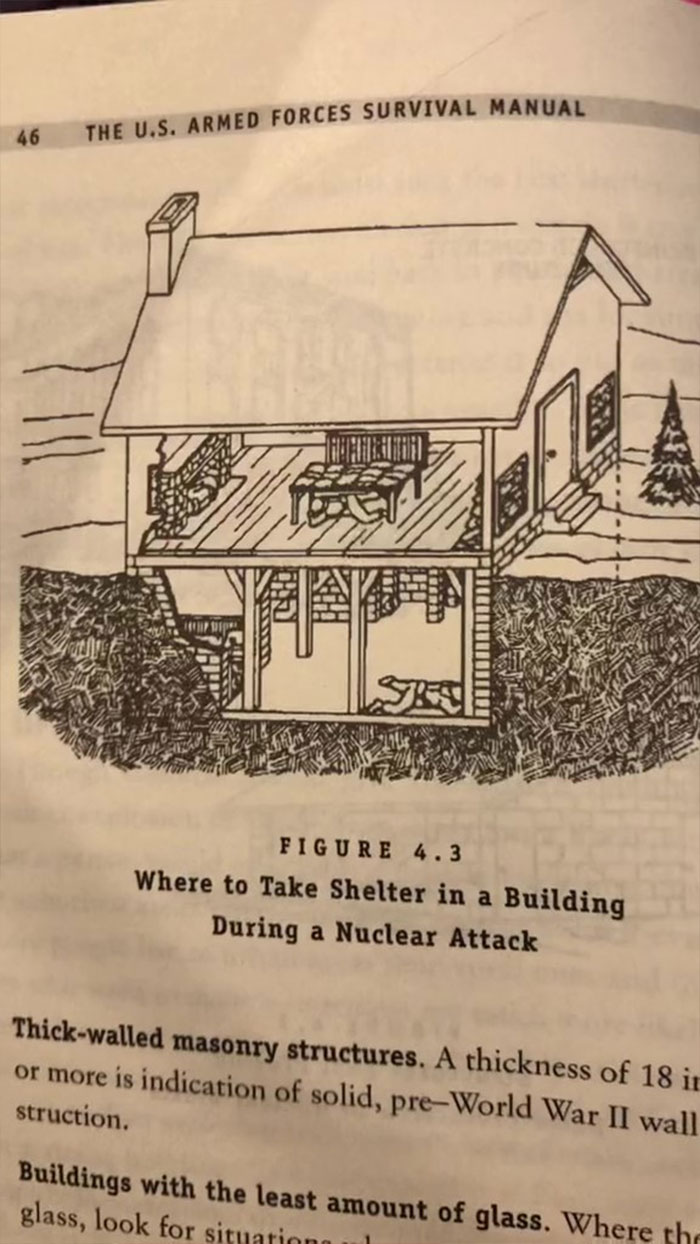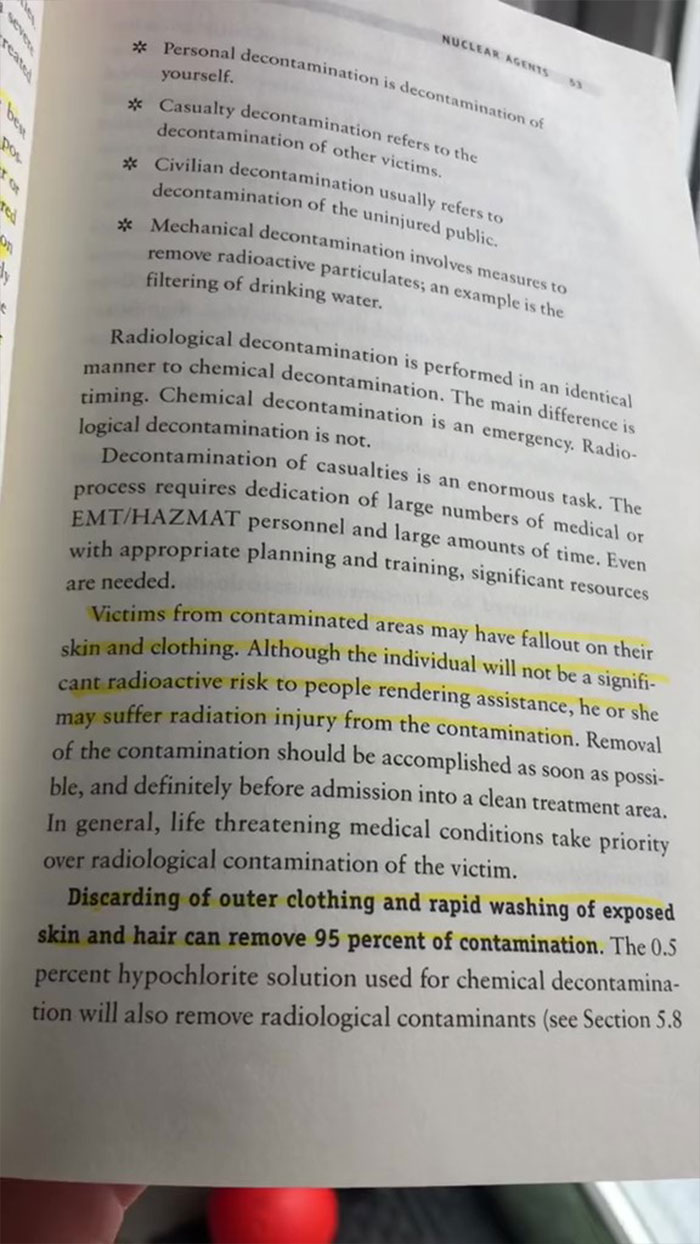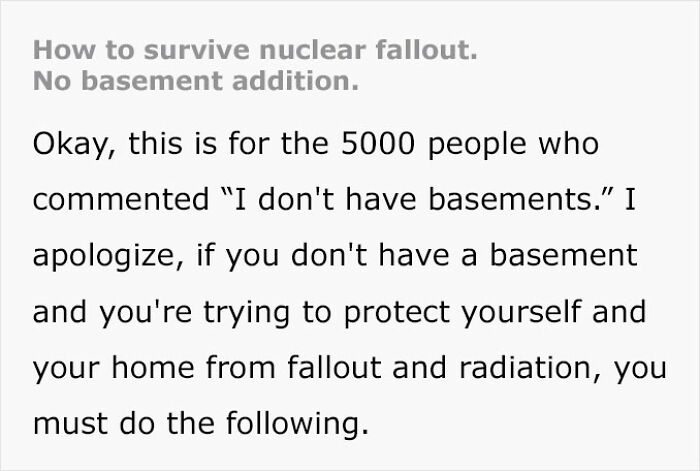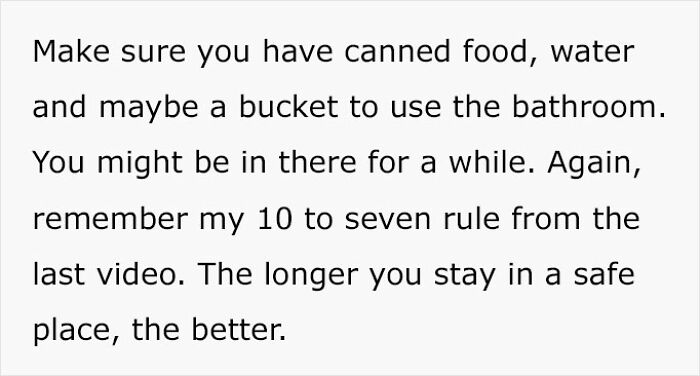
Guy Gives 8 Tips On What To Do In Case Of A Nuclear Explosion, Provided In The US Armed Forces Survival Manual
Given the whole situation with Ukraine and Russia, and the latter’s threats now involving nuclear weapons, many will agree that it’s high time to get a refresher on how to survive a nuclear explosion, but let’s hope it doesn’t happen cause the 2 we’ve already had were 2 too many.
Incidentally, a novice survivalist and off-grid outdoors lifestyle hobbyist, appropriately named Novice Prepper on TikTok, has shared some videos on how to do just that—survive a nuclear explosion.
More Info: TikTok | No Basement Edition
While everyone hopes this won’t be the case, being prepared for a nuclear explosion is something everyone should do, and this TikToker delivers
Image credits: Burnt Pineapple Productions
So, there’s a video floating about the internet that’s been going viral recently—and very appropriately so, as some nuclear weaponry threats have been thrown out there—so it’s nice to be prepared, just in case.
In his video, Novice Prepper effectively presented what the U.S. Armed Forces Nuclear, Biological, and Chemical Survival Manual said about surviving a nuclear blast.
Novice Prepper gave a brief explanation on how to best avoid the consequences of a nearby nuclear explosion
Image credits: novice_prepper
He elaborates that if you are in the actual blast radius, then there is practically no chance of you surviving that as everything within this area is completely incinerated. Considering that the blast of the nuclear bomb used in Hiroshima was around 1.5 miles (2.4 kilometers), modern bomb blasts can reach a radius of 3 to 8 miles (4.8 to 12.8 kilometers), so as NP explains, you can “bend over and kiss your [butt] good-bye”.
If that is not the case, however, and you’re around 50 to 100 miles (80 to 160 kilometers) away from the explosion, you’re gonna want to make a family action plan ahead of time, which would include everything from communication to supplies to safe locations to meet.
The key element in surviving a nuclear explosion is having sufficient cover, i.e. a basement
Image credits: novice_prepper
Ideally, you’d want to get yourself and everyone you love into a basement as most basements are encased in cinder blocks, concrete, and earth, which greatly decrease the spread of nuclear radiation and fallout.
Another thing you can do is cover up your windows with sandbags, dirt, wood insulation or anything that would help stop radiation from seeping into your home.
If you do end up getting exposed to radiation and fallout, take off your clothes, take a shower and put on some fresh clothes. If you react quickly enough, you can avoid up to 95% of contamination that could very seriously affect your skin and hair.
Another key is being far enough because if you’re within around 8 miles (or 12 kilometers) of the blast, you might end up incinerated along with your house
Image credits: novice_prepper
Now that you’re safe in your underground shelter, stay there for as long as you can, given your food and water reserves. It is said that nuclear fallout decreases significantly over time—by a factor of 10 every 7 hours, meaning that 48 to 72 hours (or 2 to 3 days) ought to be enough for levels to drop to non-lethal levels, but this 7-10 rule is considered a rule of thumb based on observed data, and hence can be a bit inaccurate.
Should you also get in contact with fallout, it is recommended to take a shower and change clothes, which gets rid of up to 95% contamination
Image credits: novice_prepper
After this video, a lot of people started asking about a situation if you don’t have a basement. Effectively, you do more of the same—encapsulate yourself in as much insulation as possible. Find the center-most point in your home on the first floor. It can be a room or a closet, but if that isn’t an option, build a fort.
Novice Prepper was also asked to provide a “no basement edition” which is more or less the same, except you bunker yourself in the center of your house
Image credits: novice_prepper
Again, use plastic, tarp, wood, blankets or anything else you can find to cover up the windows and doors. Now, nothing works as good as having a basement, but having nothing is absolutely not an option, and even things like plastic sheets will help reduce radiation levels, even if it is on a lower protection level.
Needless to say, stay there for the same amount of time, make sure you have enough food, water, and perhaps a bucket as a toilet. Remember the 7-10 rule. Also, don’t forget that you also have neighbors and if they have a basement, they will also quite likely be very welcoming. Given you’re not a neighbor from hell.
Image credits: novice_prepper
Now, if you want an even more detailed version of this, you can either get yourself a copy of said book, or you can do the faster thing and refer to Ready.Gov’s extensive, but still quick, guide on the hows and whats of nuclear explosions.
You can check out the now-viral video below
@novice_prepper How to Survive a Nuclear Explosion #survival #ww3 #nuclearbunker #military #survivalguide ♬ Creepy and simple horror background music(1070744) – howlingindicator
Novice Prepper also followed up with an emergency bag video explaining essential things to have prepared in case of an emergency
Image credits: novice_prepper
The initial video has managed to garner 4.8 million views with over 630,000 likes as of this article. The follow-up no-basement edition popped up on his channel the next day, and has gotten another 770,000 views and 62,600 likes.
So, remember these tips, find yourself a good basement (or even a bomb shelter), stay safe out there, and let us know your thoughts on this in the comment section below!
Myd ad, US Navy, on surviving nuclear war: "You don't. Drive into the nearest big city target area and get it over with."
I am SO ANGRY that ONE mentally deficient, limp dicked old man can hold this threat over the entirety of the rest of the civilised world.
Load More Replies...Can we PLEASE STOP featuring idiots talking about stuff they don't understand on tikfuck? Can we please stop featuring tikfuck altogether? It's a friggin' propaganda platform CONTROLLED BY A REGIME COMMITTING GENOCIDE AGAINST THEIR OWN PEOPLE. Why does nobody give a single fúck, seriously?
The fact that China owns TikTrash doesn’t mean that they made this video.
Load More Replies...Myd ad, US Navy, on surviving nuclear war: "You don't. Drive into the nearest big city target area and get it over with."
I am SO ANGRY that ONE mentally deficient, limp dicked old man can hold this threat over the entirety of the rest of the civilised world.
Load More Replies...Can we PLEASE STOP featuring idiots talking about stuff they don't understand on tikfuck? Can we please stop featuring tikfuck altogether? It's a friggin' propaganda platform CONTROLLED BY A REGIME COMMITTING GENOCIDE AGAINST THEIR OWN PEOPLE. Why does nobody give a single fúck, seriously?
The fact that China owns TikTrash doesn’t mean that they made this video.
Load More Replies...























54
84